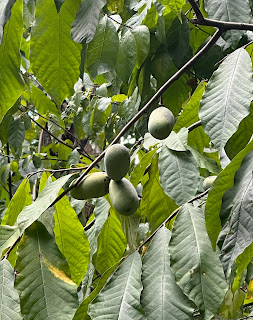There it was, laying next to the grass trimmer I was about to start: a paw paw, the first fruit of the season. Suzanne had found it doing yard work. It was ripe, and I took a bite. Fantastic!
Paw paw has an Appalachian ring to it, sounding like a dog extremity or ma's husband. A paw paw is a greenish potato-sized wild fruit which grows on 20-30 foot tall trees in deep woods throughout the midwest and south. It has never been a mainstream fruit: It bruises easily, spoils quickly, messy to eat, full of seeds. And the trees are hard to find in the wild. Darn.
The taste is captivating to many, described by one food writer as: "...sunny, electric, and downright tropical: a riot of mango-banana-citrus flavor." The best tasting paw paws are ones picked up within a day or two after falling from the tree. I eat them like corn on the cob - munch around the outside and discard the middle where the seeds are. And I don’t eat too much - more on that later.
Paw paws have a centuries-old history. They are considered the largest edible fruit native to North America. Indians consumed them long before white settlers arrived. The scientific name for paw paw is Asimina Triloba; Asimina is a Native American word. The name of the Natchitoches tribe is said to translate as "paw paw eater." I was surprised to learn that the Powhatan Indians not only ate wild paw paws but actually kept orchards of them. Food historian Justin Cherry wrote that George Washington expanded his orchards with paw paw trees. On March 7, 1785, he wrote: “Planted… all my papaw (trees).” Thomas Jefferson also grew paw paws; the tree appears on a list in his own handwriting. The Lewis Clark Expedition ate paw paws, relying on them for survival toward the end of the expedition. September 18, 1806: “…our party entirely out of provisions Subsisting on poppaws”
The 1749 French expedition in the upper Ohio Valley also saw paw paws. The priest and navigator, Father Bonnecamps, was also a trained scientist. He described the paw paw fruit in detail and called it a "delicate morsel for the (Indians) and Canadians," though he found it "unendurable." He said that paw paw in French was Testiculi Asini, roughly translated "testicle fruit," since the fruit's shape is similar to - well, you get the idea. He described that term "not very refined." Locally, paw paws did not make history headlines. But they were here, and people ate them, in one case erroneously calling them “May apples” – spring wildflowers with small inedible berry-sized “apples”.
Today you can eat the fruit or try the many paw paw related foods and beverages. Think paw paw bread, jellies, sorbet, and beer or wine. Paw paw fruit has nutritional benefits, being rich in vitamin C, magnesium, iron, manganese, and potassium. But - remember my earlier comment not to overdo eating the paw paw fruit? Paw paw trees have a very active chemistry. Overeating may bring intestinal discomfort or worse. Paw paw extract was advertised in the late 1800s as a cathartic – you can search that word on your own.
I have noticed that after eating a paw paw, my appetite wanes for a time. Imagine, a new appetite suppressant as an alternative to popular weight loss drugs. Opportunity awaits in the woods near you.
So, live on the edge; explore paw paws. People may look at you strangely if you brag about paw paw knowledge. But you can feel the pride of being a paw paw cult follower.
